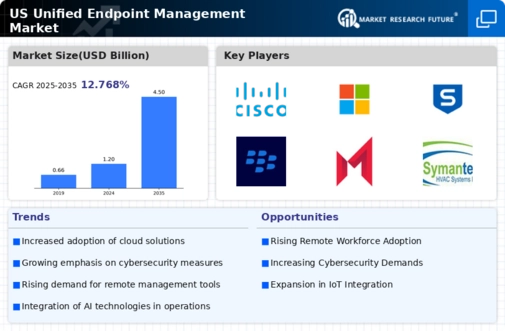Integration of IoT Devices
The proliferation of Internet of Things (IoT) devices is reshaping the landscape of the unified endpoint-management market. As businesses increasingly adopt IoT technologies, the complexity of managing these devices alongside traditional endpoints grows. A recent study suggests that the number of connected IoT devices in the US is expected to reach 30 billion by 2025, creating a pressing need for comprehensive management solutions. The unified endpoint-management market is adapting by developing tools that can integrate and manage these diverse devices, ensuring they operate securely and efficiently within corporate networks. This integration not only enhances operational efficiency but also mitigates potential security risks associated with unmanaged IoT devices, positioning the market for substantial growth.
Rising Cybersecurity Threats
The escalating frequency and sophistication of cyber threats are compelling organizations to prioritize endpoint security, thereby driving growth in the unified endpoint-management market. With cyberattacks on the rise, businesses are increasingly aware of the vulnerabilities associated with unmanaged endpoints. Reports indicate that 60% of small to medium-sized enterprises in the US have experienced a cyber incident in the past year, highlighting the urgent need for robust endpoint management solutions. The unified endpoint-management market is responding by offering advanced security features, such as real-time monitoring and automated threat detection, to safeguard sensitive data. As organizations strive to protect their digital assets, investment in unified endpoint management is likely to surge, reflecting a proactive approach to cybersecurity.
Regulatory Compliance Requirements
The landscape of regulatory compliance is becoming increasingly complex, prompting organizations to seek unified endpoint-management market solutions that ensure adherence to various standards. Regulations such as the General Data Protection Regulation (GDPR) and the Health Insurance Portability and Accountability Act (HIPAA) impose stringent requirements on data management and security. As businesses in the US navigate these regulations, the demand for endpoint management solutions that facilitate compliance is expected to rise. The unified endpoint-management market is evolving to provide tools that not only streamline compliance processes but also enhance data security. This focus on compliance is likely to drive market growth, as organizations recognize the importance of mitigating legal risks associated with non-compliance.
Advancements in Artificial Intelligence
The integration of artificial intelligence (AI) into endpoint management solutions is transforming the unified endpoint-management market. AI technologies enable organizations to automate routine tasks, enhance threat detection, and improve decision-making processes. As AI capabilities continue to advance, businesses are increasingly leveraging these technologies to optimize their endpoint management strategies. A survey indicates that 45% of IT leaders in the US are planning to invest in AI-driven endpoint management solutions within the next year. The unified endpoint-management market is responding by developing innovative AI-powered tools that provide predictive analytics and automated responses to security incidents. This trend suggests a future where AI plays a pivotal role in shaping the efficiency and effectiveness of endpoint management.
Growing Demand for Remote Work Solutions
The shift towards remote work has catalyzed a growing demand for unified endpoint-management market solutions. Organizations are increasingly seeking to manage a diverse array of devices, including laptops, smartphones, and tablets, from various locations. This trend is underscored by a report indicating that 70% of companies in the US have adopted remote work policies, necessitating robust endpoint management to ensure security and efficiency. The unified endpoint-management market is responding to this demand by offering solutions that facilitate seamless access to corporate resources while maintaining stringent security protocols. As remote work becomes a permanent fixture in many organizations, the need for effective management of endpoints is likely to continue its upward trajectory, driving innovation and investment in this sector.






















Leave a Comment